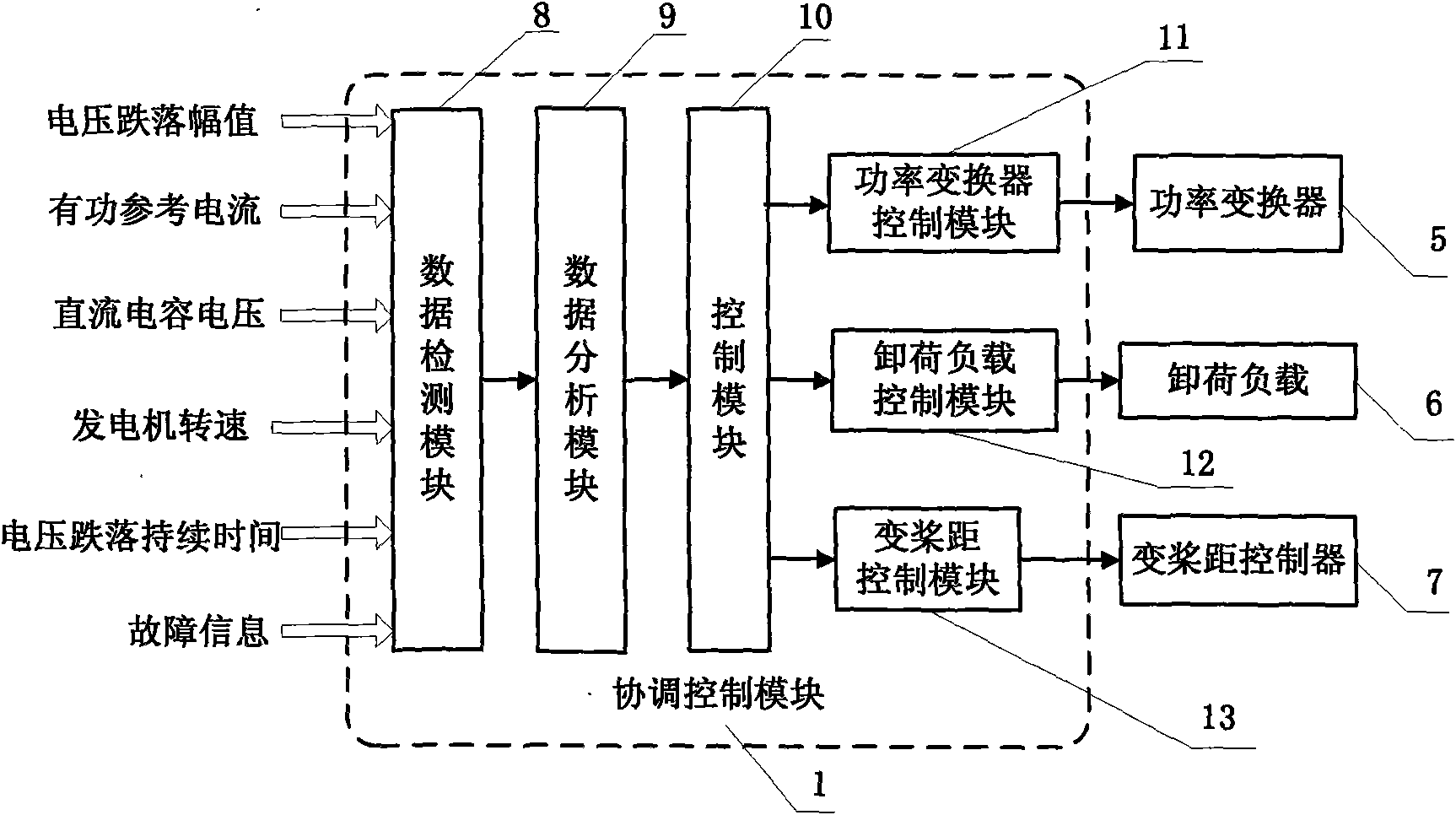Coordination control method for LVRT (Low Voltage Ride Through) of wind turbine
A technology of coordinated control and wind turbines, applied in the control of wind turbines, wind power generation, wind turbines, etc., can solve the problem of easy disconnection of wind turbines from the grid, enhance reactive power control capabilities, ensure rapid recovery, and restrain overspeeding. Effect
- Summary
- Abstract
- Description
- Claims
- Application Information
AI Technical Summary
Problems solved by technology
Method used
Image
Examples
Embodiment 1
[0015] Embodiment 1, by figure 1 , figure 2 It can be seen that when the transmission line fails, the early warning module 4 generates an "early warning" signal, and the coordination control module 1 sends an instruction to the pitch controller 7 to enable the fault pre-pitch mode, and the pitch controller 7 changes the pitch at a certain The speed increases the pitch angle, reduces the capture of wind energy, and reduces the output power of the wind turbine. The wind power SCADA system voltage drop analysis module 3 calculates the voltage drop amplitude and duration, and the data analysis module 9 in the coordination control module 1 detects whether the voltage drop amplitude is lower than the lower limit value, and if so, switches the power converter 5 The operation mode, from PWM control mode to STATCOM mode, prevents the voltage from continuing to drop, otherwise it maintains the original working mode. Since the distance protection and differential protection are widely...
Embodiment 2
[0016] Embodiment 2, by figure 2 , image 3 It can be seen that when the power distribution line fails, the pitch controller 7 enters the fault pre-pitch mode under the action of the "early warning" signal, and the voltage drop analysis module 3 of the wind power SCADA system calculates the voltage drop amplitude and duration. Most of the protection of distribution lines is over-current protection, and segmental over-current protection increases the time for fault removal, resulting in an increase in the duration of instantaneous voltage drops. Assuming that both the amplitude and the duration of the voltage drop exceed the limit value, at this time, the power converter 5 and the unloaded load 6 cannot meet the requirements. The pitch controller 7 switches from the pre-pitch mode to the failure emergency pitch mode, so that the pitch angle of the wind turbine increases rapidly with the maximum pitch change rate, rapidly reduces the wind energy captured by the fan, and reduce...
Embodiment 3
[0017] Embodiment 3, by figure 2 , image 3 It can be seen that when the fault point is far away, the "early warning" signal is generated by the early warning module 4, and the pitch change work is switched to the fail-safe pitch change mode. The analysis result of the voltage drop analysis module 3 of the wind power SCADA system is that the impact of the fault on the current wind farm is very small, that is, when the amplitude of the voltage drop time is very small and the duration is also very short, the coordination control module 1 does not need to be put into the fault emergency pitch change mode, When the voltage drops, the impact of the voltage drop on the wind turbine is further reduced in the fault pre-pitch mode. At this time, there is no need to put in the unloading load 6, and the power converter 5 still works normally. At this time, it can be completely adjusted by the motor itself. Ability to realize LVRT function.
PUM
 Login to View More
Login to View More Abstract
Description
Claims
Application Information
 Login to View More
Login to View More - R&D
- Intellectual Property
- Life Sciences
- Materials
- Tech Scout
- Unparalleled Data Quality
- Higher Quality Content
- 60% Fewer Hallucinations
Browse by: Latest US Patents, China's latest patents, Technical Efficacy Thesaurus, Application Domain, Technology Topic, Popular Technical Reports.
© 2025 PatSnap. All rights reserved.Legal|Privacy policy|Modern Slavery Act Transparency Statement|Sitemap|About US| Contact US: help@patsnap.com



